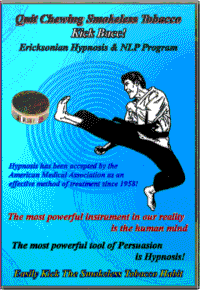|
|
 For a large percentage of the world's population, smokeless tobacco is at least something they have tried, if not something indulged in regularly. Most people associate smokeless tobacco with sports stars, and falsely believe that it is a safe alternative to smoking. Unfortunately for them, this can all too often prove dead wrong. For a large percentage of the world's population, smokeless tobacco is at least something they have tried, if not something indulged in regularly. Most people associate smokeless tobacco with sports stars, and falsely believe that it is a safe alternative to smoking. Unfortunately for them, this can all too often prove dead wrong.
All different types of people use this highly addictive substance and no one is safe dependent on race, income, or sex. The reasons for going smokeless vary widely from appetite control to generalized stress relief. And this epidemic is hurting the world. Targeting the world's future with the predominant users being only teens and in many cases preteens, it is very dangerous stuff.
The truth of the matter is that teens and smokeless tobacco are getting to be to familiar with each other and creating lifelong habits and heath risks that are just too great to be overlooked and too dangerous to be ignored. Child use of smokeless tobacco is on the constant rise, with some users starting when they are only 9 or 10.
Rural Caucasian teens have the highest risk of using smokeless, and if the teens live in a house with an adult that uses, their chances of following the trend rises dramatically. In U.S. high school students grades 9-12, an average of 9.3% use smokeless tobacco. In white male students the average is about 1 user in 5 students.
But what are the effects of smokeless tobacco and what are the pros and cons of using it? On the plus side of course is looking cool, and fitting in. Also it causes an odd sensation in users by first calming them, by the release of dopamine in the brain, and then exciting them with a release of adrenaline. Also the appetite is reduced.
On the down side are more ramifications that make the reasons to chew look pretty weak. Use of smokeless tobacco causes a wide variety of cancers, along with dental problems, bad breath, and of course the financial spending of the user to supply this high. Most tobacco users with a can a day habit, over 30 years at current prices will spend up to $50,000 on chewing tobacco, assuming they live that long.
There are no known cures for either the gastrointestinal nor the Oral cancer smokeless tobacco brings, and this also can cost hundreds of thousands of dollars in treatment and ultimately funeral costs.
Quitting smokeless tobacco is widely thought to be much more difficult than kicking the smoking habit. A part of the addiction is the tremendous nicotine absorbed by the body while dipping or chewing. This amount is twice as high as received from smoking a cigarette.
But how can one quit smokeless
tobacco? Various products are on the market to help wean users off of snuff and chew, such as a product that uses spearmint leaves to mimic the tobacco without getting the nicotine. And some success has been shown with the same shot that inhibits receptors for smoking. But the way to stop and stay quit without withdrawal, stress, and weight gain is through hypnosis.
Hypnosis offers a two-fold attack to the systematic dipping or chewing reflex built up by your previous habits and lifestyle choices. It first attacks the emotional reasons why you need a dip, and then it attacks the mental habit itself.
First you'll want to consider the emotional reasons. Dopamine is a "feel good" chemical produced in your body and released by your brain during times of happiness. In times of stress the dopamine produces a general feeling of well-being. Some common occurrences of natural release include eating a large meal, or sexual relief. In other words, putting some chew into the mouth provides relaxation and pleasure. The very essence of hypnosis is relaxation, and self-hypnosis
Hypnosis also works to break the cycle of expectation that your mind creates. When you put in a chew after dinner, your mind begins to tell your body that you need a chew after every dinner. By blocking or removing this thought process, you will not feel compelled to pack your cheek, after you pack your stomach.
By attacking these two root causes of chewing tobacco use, hypnotherapy can virtually eliminate the urge to dip or chew, stopping your need for the extra dopamine release. Thus releasing you from this surely deadly habit and allowing a stress free method of stopping.

� 2007 By
Alan B. Densky, CH. This
document may NOT be re-printed. All Rights Reserved.
|
|


